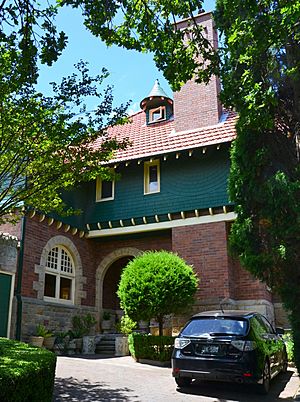Hollowforth facts for kids
Quick facts for kids Hollowforth |
|
|---|---|

Hollowforth, pictured in 2012.
|
|
| Location | 146 Kurraba Road, Kurraba Point, North Sydney Council, New South Wales, Australia |
| Built | 1893–1893 |
| Built for | Professor Richard Threlfall |
| Architect |
|
| Architectural style(s) | Federation Arts and Crafts |
| Official name: Hollowforth | |
| Type | State heritage (built) |
| Designated | 2 April 1999 |
| Reference no. | 450 |
| Type | House |
| Category | Residential buildings (private) |
| Lua error in Module:Location_map at line 420: attempt to index field 'wikibase' (a nil value). | |
Hollowforth is a special old house in Kurraba Point, a suburb of Sydney, Australia. It's known for its unique design and is considered a very important historical building. The house was built in 1893 and was designed by a famous architect named Edward Jeaffreson Jackson, along with S. G. Thorp. Today, Hollowforth is privately owned, but it's protected because it's listed on the New South Wales State Heritage Register. This means it's a significant part of New South Wales's history and architecture.
Contents
A Look Back at Hollowforth's Story
Hollowforth was finished in 1893. It was built as the home for Professor Richard Threlfall. The house was designed by E. Jefferson Jackson, working with S. G. Thorp.
Later, in 1913, a billiard room (a room for playing pool) was added to the house. It also had a bedroom built above it. This work was done for the owner at the time, A. H. Way, by architects Spain and Cosh.
Who Was Professor Richard Threlfall?
Sir Richard Threlfall (1861-1932) was a brilliant scientist. He was a physicist and a chemical engineer. He was born in England in 1861.
Richard Threlfall went to college at Cambridge University. He also studied in Germany. Even though he lost some fingers in an experiment, he was known as an amazing experimenter.
In 1886, Threlfall became the head of physics at the University of Sydney. He was perfect for the job. He wanted to make the university's physics department one of the best. He brought new ideas and equipment. He even convinced the university to build a new science building, which was finished in 1888.
Threlfall worked on many interesting projects. He studied explosives and how explosions spread. He also looked at how electricity moves through materials like sulfur. With his student, J. A. Pollock, he invented a special tool to measure gravity. They used this tool to take measurements all over eastern Australia.
In 1898, he left Australia and moved back to England. He became a director at a chemical company. He was also chosen to be a member of the Royal Society in London, which is a very important group for scientists.
Later Owners of Hollowforth
Professor Threlfall kept the lease for the land where Hollowforth stands until 1908. That's when Arthur H. Way took over the lease. Arthur H. Way owned a department store called E. Way & Co. in Sydney. In 1913, he bought the land outright, becoming the full owner of Hollowforth.
What Does Hollowforth Look Like?
Hollowforth has a very special look. It shows the influence of the Art Nouveau style. This style uses flowing, natural shapes and patterns. You can see this in the unique patterns of the shingled walls.
The roof of Hollowforth is also very striking. It has different levels and shapes, with stepped hips and broken gables. There are also big brick chimneys and windows that stick out from the roof, called dormer windows, with pointy tops.
The upper parts of the walls are covered in shingles, which are like small wooden tiles. These shingled walls curve out over the lower brick walls. The whole house sits on a strong sandstone base. You'll notice many different shapes of windows, which was common for houses built around this time.
Inside, Hollowforth has beautiful Art Nouveau details. This includes special stained glass windows (called leadlighting), stair railings (balusters) that get thinner at the bottom, and unique wooden details. Before it was divided into two separate homes, the house was used as many small apartments.
Hollowforth is a very important example of the "shingle style" of architecture. It was designed by E. Jeaffreson Jackson, who was a leading architect of his time. The house is considered one of the best examples of this style in New South Wales. Its beautiful garden setting also adds to its importance. The way the rooms are laid out inside, and their size and details, are also very significant.
Why Hollowforth is a Heritage Site
Hollowforth was added to the New South Wales State Heritage Register on April 2, 1999. This means it's recognized as a very important historical place. It met certain rules to be listed:
Important People and History
Hollowforth is linked to important people and the history of New South Wales. Its architect, E. Jefferson Jackson, was a top architect of his time. Hollowforth is seen as one of the finest examples of the shingle style in the state, similar to other famous houses designed by Horbury Hunt.
Beautiful and Creative Design
Hollowforth is a truly special building. It's an amazing example of the American shingle style. It also shows influences from the Art Nouveau and Federation Arts and Crafts movements. This makes it very creative and unique.
The house is located on a curve in the road. This position makes Hollowforth an important part of the street's look. It fits in well with the style of the houses around it.


